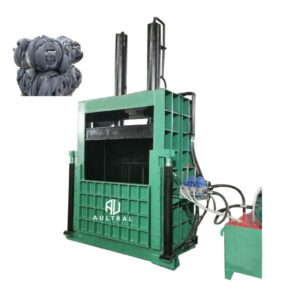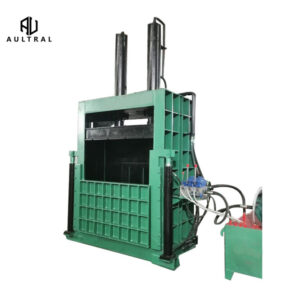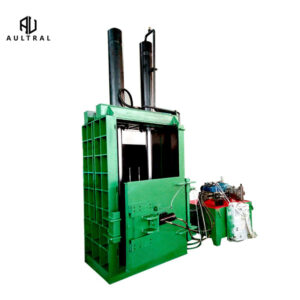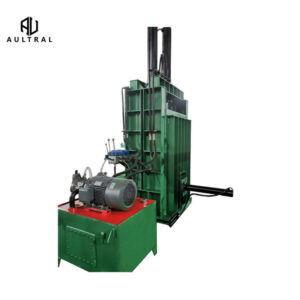In the ever-evolving world of recycling, the vertical tyre baler has emerged as an essential tool for businesses focused on tire waste management. With the increasing environmental impact of discarded tires, recycling them efficiently has become a priority for many industries. The vertical tyre baler is designed to help recycle tires quickly, effectively, and in a manner that conserves valuable space while also ensuring higher productivity. Whether you’re operating a scrap yard, a tire recycling facility, or a manufacturing plant, investing in a vertical tyre baler can offer a host of advantages.
What is a Vertical Tyre Baler?
A vertical tyre baler is a specialized machine designed to compress used tires into compact, manageable bales. By applying hydraulic force, the machine presses tires tightly into uniform bales, which can be stored or transported more efficiently. Unlike traditional waste disposal methods, which may leave tires scattered and difficult to handle, the vertical tyre baler streamlines the process, helping businesses optimize their operations and minimize the environmental impact of tire waste.
How Does a Vertical Tyre Baler Work?
The working mechanism of a vertical tyre baler is simple yet powerful. The machine uses hydraulic pressure to compress the tires into a tight, uniform shape. Tires are fed into the baling chamber, where the vertical press applies force from top to bottom. The high-pressure hydraulic system ensures that the tires are compacted efficiently, reducing their size by a significant margin. Once the bale is formed, it is tied off with steel wire or strapping, making it easy to handle and transport.
The vertical design of the machine allows for maximum use of vertical space, making it ideal for businesses with limited floor area. The process is automated, allowing operators to load tires into the machine, press them into bales, and then eject the finished bale with minimal intervention.
Key Benefits of a Vertical Tyre Baler
-
Space-Saving Design: One of the most significant advantages of the vertical tyre baler is its compact, vertical design. The machine requires less floor space than horizontal balers, which is ideal for businesses with limited operational space. By optimizing vertical space, businesses can store more tires in less space, improving overall efficiency in tire recycling operations.
-
Improved Efficiency and Productivity: The vertical tyre baler operates quickly, allowing for fast tire compaction and high-volume processing. The hydraulic system generates enough pressure to compress even large, bulky tires into tight bales. This increases productivity by reducing the time spent on each bale and allowing for continuous operation. Moreover, its automated function minimizes manual labor, allowing operators to focus on other tasks.
-
Cost-Effective: A vertical tyre baler offers a significant return on investment (ROI) by reducing waste volume and optimizing space. With less material to transport, businesses can save on fuel and transportation costs. Additionally, the compact bales produced by the baler are easier to handle and ship, reducing overall operational costs and improving the profitability of recycling operations.
-
Environmental Impact Reduction: Recycling tires is an essential step in mitigating the environmental hazards caused by tire waste. Tires that are not recycled may end up in landfills, contributing to pollution and environmental damage. By using a vertical tyre baler to compress tires, businesses can ensure that they are properly processed, reducing their environmental footprint. The compact bales also make it easier to transport tires to recycling plants, where they can be further processed into new products, such as rubber mats, road surfaces, or even energy.
-
Durable and Low-Maintenance: The vertical tyre baler is built with durability in mind. Made from high-quality materials, it is designed to handle the rigors of continuous, heavy-duty use. Additionally, these machines are relatively low-maintenance, with minimal downtime required for repairs. Proper maintenance, such as regular hydraulic system checks and cleaning, ensures the machine operates efficiently for many years.
-
Enhanced Safety: Vertical tyre balers come equipped with several safety features to protect operators during use. These may include emergency stop buttons, pressure relief valves, and automatic safety mechanisms that prevent accidents. The design of the machine minimizes the risk of injury by keeping moving parts enclosed and away from the operator.
Applications of Vertical Tyre Balers
The vertical tyre baler is used in various industries and applications, including:
-
Tire Recycling: The baler is ideal for compressing used tires before they are sent to recycling facilities, where they can be repurposed into new products.
-
Scrap Yards: It helps scrap yards compact tire waste into manageable bales, improving storage and transport efficiency.
-
Manufacturing: Manufacturers dealing with large volumes of scrap tires from production processes use the vertical tyre baler to process waste materials.
-
Landfills and Waste Management: Waste management facilities use vertical tyre balers to reduce tire volumes before disposal or recycling, making the disposal process more efficient.
The vertical tyre baler offers an efficient, space-saving, and cost-effective solution for businesses involved in tire recycling, scrap processing, and waste management. With its high compression power, automated operation, and ability to reduce waste volume, it significantly boosts productivity and profitability while also contributing to more sustainable recycling practices. Whether you are looking to optimize your tire recycling operation, reduce transportation costs, or minimize your environmental impact, the vertical tyre baler is an investment that will help streamline your waste management processes for years to come.
By implementing this advanced technology, you can ensure that your business stays ahead in the ever-growing recycling industry, contributing to a cleaner, greener future while maximizing your operational efficiency.





